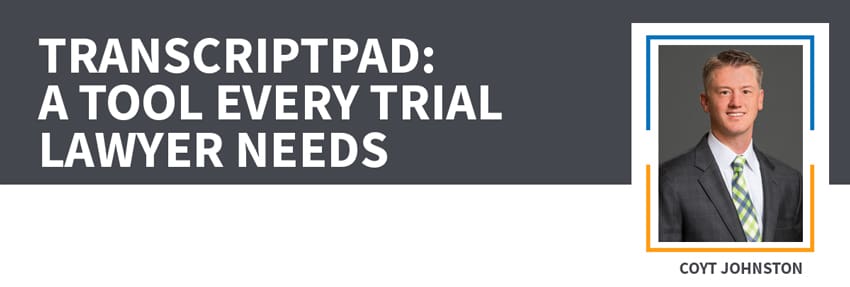
TranscriptPad is an iPad App developed by Lit Software. It is an application developed specifically for lawyers to review transcripts. Overall, TranscriptPad is a well designed and affordable tool that every trial lawyer should have in his or her arsenal.
First review value – All civil trial lawyers review transcripts. Often, transcripts are first reviewed and highlighted at earlier stages of the case, and then only used much closer to trial. That means that months or even years may elapse between the first and second reviews. That typically means that the second review is nearly a complete redo of the first, as people rarely remember detailed information across that span of time. TranscriptPad allows you to mark, highlight, and issue-code the transcript on the first pass—meaning you can hit the ground running on your second pass months later.
Issue Codes – Issue codes are a way of assigning custom labels to portions of the transcript. For instance, in a fraud case, “reliance” might be an issue in the case and therefore an issue code you would use. When the transcript refers to a question or answer that relates to “reliance,” you simply mark the passage with that issue code. This enables you to look up portions of the transcript by issue code and is a way of reminding yourself of what you were thinking on the first review. TranscriptPad also allows you to assign multiple issue codes to the same portions of the transcript. For instance, you might assign a portion of the transcript to both “reliance” and “mitigation.” When you look up either issue code, the assigned portion will show up.
Collaboration – Often, more than one lawyer needs to review a transcript. Perhaps an associate takes the first review and a partner reviews associate’s effort. TranscriptPad is great for this situation because an associate can share the completed review—including highlighting and issue codes—for the partner to see. Then the partner can build right on top of the associate’s work. This is also a great feature when you have multiple lawyers on a team that might be working on different aspects of the case, but still, need to know what the other players are doing.
Reports – The reports that you can get after reviewing the transcript are very helpful. Not only can you easily see all the portions of the transcript that you tagged along with the issue codes, but it will show you the actual questions and answers—with the page and line number. That makes it very easy to reference a particular portion of the transcript in a pleading.
Exhibits – TranscriptPad allows you to import .pdf exhibits so that deposition exhibits are available to you when reviewing the transcript. But admittedly, this feature is a bit clunky when compared to the smoothness of the rest of the program. The exhibits are not linked in the deposition, but just available to review. You have to get out of the transcript part and navigate your way to the exhibit; then, after you finish reviewing the exhibit, you must navigate your way back. The whole thing is not terribly burdensome and can be accomplished without much trouble, but it would be very nice if the program would assign some type of hyperlinks that would jump to the linked exhibit and then back.
